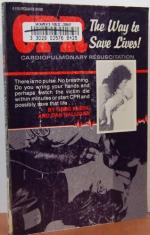|
This section contains 1,468 words (approx. 5 pages at 300 words per page) |

|
Cardiopulmonary resuscitation (CPR) is a procedure to support and maintain breathing and circulation for a person who has stopped breathing (respiratory arrest) and/or whose heart has stopped (cardiac arrest).
CPR is performed to restore and maintain breathing and circulation, and to provide oxygen and blood flow to the heart, brain, and other vital organs. CPR should be performed if a person is unconscious and not breathing. Respiratory and cardiac arrest can be caused by allergic reactions, an ineffective heartbeat, asphyxiation, breathing passages that are blocked, choking, drowning, drug reactions or overdoses, electric shock, exposure to cold, severe shock, or trauma. CPR can be performed by trained bystanders or healthcare professionals on infants, children, and adults. It should always be performed by the person on the scene who is most experienced in CPR.
CPR is part of the emergency cardiac care system designed to...
|
This section contains 1,468 words (approx. 5 pages at 300 words per page) |

|


